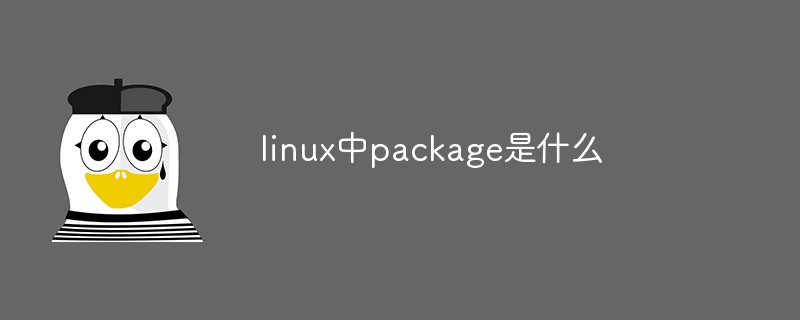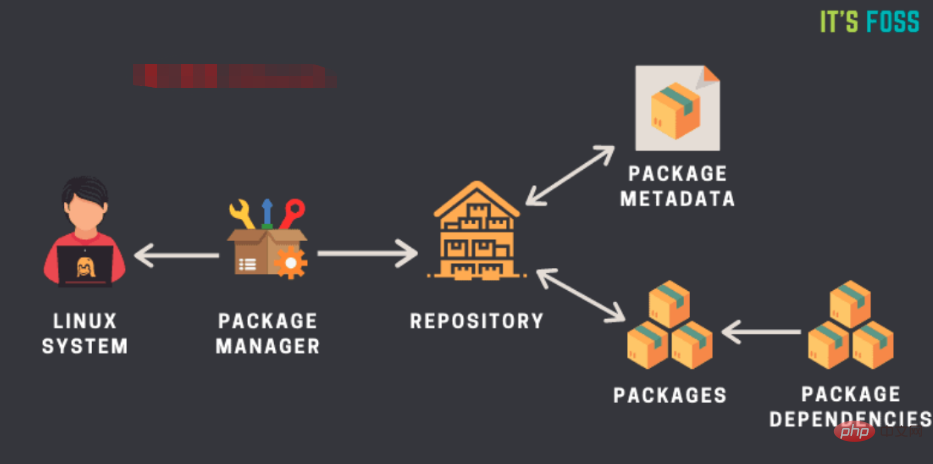
In Linux, package refers to a package, that is, an application, which can also be a GUI application, a command line tool, or a software library; a package is essentially an archive file, which contains a binary executable file, Configuration file, also contains information about dependencies.

#The operating environment of this tutorial: linux7.3 system, Dell G3 computer.
A package usually refers to an application, but it can also be a GUI application, command line tool, or software library (required by other software programs) . A package is essentially an archive file that contains a binary executable, configuration files, and sometimes information about dependencies.
What is the package manager in Linux?
One of the main differences between Linux distributions is the package management system.
Simply put, a package manager is a tool that allows users to install, remove, upgrade, configure and manage software packages on the operating system. A package manager can be a graphical application, such as Software Center, or a command-line tool, such as apt-get or pacman.
What is a package?
A package usually refers to an application, but can also be a GUI application, command line tool, or software library (required by other software programs). A package is essentially an archive file that contains a binary executable, configuration files, and sometimes information about dependencies.
In the past software was often installed from its source code. You can generally refer to a file (usually named readme) and see what software components it requires and the location of the binaries. The readme usually also contains configuration scripts or makefiles. You must compile the software yourself or handle all dependencies yourself (some software requires other software to be installed).
To get rid of this complicated approach, Linux distributions have created their own packaging formats that provide end users with ready-made binaries (precompiled software), as well as some metadata (version number, description) and dependencies Item is used to install software.
Around the mid-1990s, Debian created the .deb or DEB packaging format, and Red Hat Linux created the .rpm or RPM (short for Red Hat Package Manager) packaging system. Compiling source code still exists, but is now just an optional way to install software.
To interact with or use the packaging system, you also need a package manager.
How do package managers work?
Package manager is a general concept and not unique to Linux. You will come across package managers for different software or programming languages, there is PIP package manager specifically for Python packages, and even the Atom editor has its own package manager.

Almost all Linux distributions have software repositories, which are basically collections of software packages. Yes, there may be multiple repositories. Repositories contain different types of packages.
Repositories also have metadata files that contain information about the package, such as package name, version number, package description, repository name, etc. You will see this information when you use the apt show command in Ubuntu/Debian.
The system's package manager interacts with metadata first. The package manager creates a local cache of metadata on the system. When you run your package manager's update option (such as apt update), it updates the local cache of this metadata by referencing the metadata in the repository.
The package manager references this cache when you run the package manager's installation command (such as apt install package_name). If it finds the package information in the cache, it uses the Internet connection to connect to the appropriate repository and first downloads the package before installing it on the system.
A package may have dependencies. This means it may require additional packages to be installed. Package managers usually handle dependencies and install them automatically along with the package you are installing. Likewise, when you use the package manager to delete a package, it will automatically delete or notify you that the system has unused packages that can be cleaned up.
In addition to the obvious tasks of installing and removing, you can also use a package manager to configure packages and manage them as needed. For example, you can prevent package versions from being upgraded from regular system updates.
Recommended learning: Linux video tutorial
The above is the detailed content of What is package in linux. For more information, please follow other related articles on the PHP Chinese website!